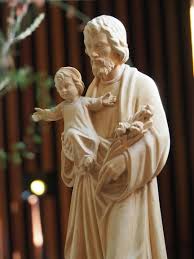St Joseph is the person who was closest to Jesus and Mary. We know little about Joseph. When we read about Joseph in the gospels, the stories are about crises. When Joseph learns that Mary is pregnant, he decides to arrange for a discreet separation. He cannot entertain the prospect of Mary being publicly disgraced.
Divine intervention moves to halt this intended action. The Roman decree requiring Joseph and Mary to travel to Bethlehem would have been a traumatic journey. Jesus was born in a stable ‘because there was no place for them in the inn. The flight into Egypt and the loss of Jesus in the Temple were further occasions of anguish and inconvenience.
Joseph, Mary and Jesus lived in the remote little village of Nazareth. Jesus probably followed his father’s profession as a tradesman. We do not know when Joseph died but when the gospels record that Jesus began his public ministry, there is no mention of Joseph.
Public devotion to Joseph developed rather late in the story of the church’s litany of saints. We have some mention of devotion to Joseph in the 8th Century. Joseph’s popularity owes much to the promotion by St Bernardine of Siena in the 15th Century and St Teresa of Avila in the 16th Century. In 1870 Pope Pius IX named St Joseph as patron of the church. Pope John XXIII declared Joseph the patron of the Second Vatican Council.
Popular art has not always helped the cause of St Joseph. He has often been portrayed as a venerable old figure standing chastely beside the beautiful Mary, dispelling any impression of the prospect of romantic love between the couple!
The Joseph of history was probably about 20 years old when he married Mary, a vital young Jew with all the emotions, struggles and trials of a Jewish man in the political cauldron of living in first century Palestine.
